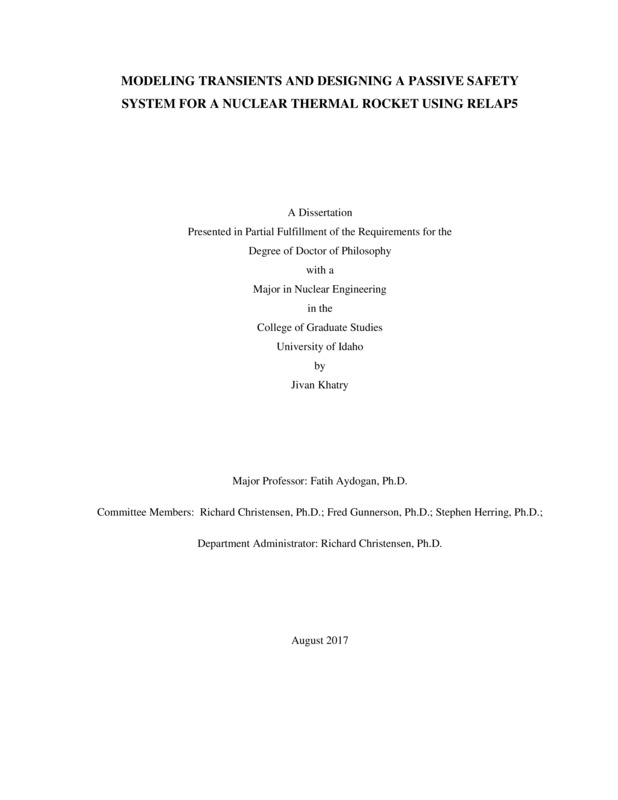MODELING TRANSIENTS AND DESIGNING A PASSIVE SAFETY SYSTEM FOR A NUCLEAR THERMAL ROCKET USING RELAP5
Khatry, Jivan. (2017-08). MODELING TRANSIENTS AND DESIGNING A PASSIVE SAFETY SYSTEM FOR A NUCLEAR THERMAL ROCKET USING RELAP5. Theses and Dissertations Collection, University of Idaho Library Digital Collections. https://www.lib.uidaho.edu/digital/etd/items/khatry_idaho_0089e_11166.html
- Title:
- MODELING TRANSIENTS AND DESIGNING A PASSIVE SAFETY SYSTEM FOR A NUCLEAR THERMAL ROCKET USING RELAP5
- Author:
- Khatry, Jivan
- Date:
- 2017-08
- Program:
- Nuclear Engineering
- Subject Category:
- Nuclear engineering
- Abstract:
-
Long-term high payload missions necessitate the need for nuclear space propulsion. Several nuclear reactor types were investigated by the Nuclear Engine for Rocket Vehicle Application (NERVA) program of National Aeronautics and Space Administration (NASA). Study of planned/unplanned transients on nuclear thermal rockets is important due to the need for long-term missions. A NERVA design known as the Pewee I was selected for this purpose. The following transients were run: (i) modeling of corrosion-induced blockages on the peripheral fuel element coolant channels and their impact on radiation heat transfer in the core, and (ii) modeling of loss-of-flow-accidents (LOFAs) and their impact on radiation heat transfer in the core. For part (i), the radiation heat transfer rate of blocked channels increases while their neighbors’ decreases. For part (ii), the core radiation heat transfer rate increases while the flow rate through the rocket system is decreased. However, the radiation heat transfer decreased while there was a complete LOFA. In this situation, the peripheral fuel element coolant channels handle the majority of the radiation heat transfer. Recognizing the LOFA as the most severe design basis accident, a passive safety system was designed in order to respond to such a transient. This design utilizes the already existing tie rod tubes and connects them to a radiator in a closed loop. Hence, this is basically a secondary loop. The size of the core is unchanged. During normal steady-state operation, this secondary loop keeps the moderator cool. Results show that the safety system is able to remove the decay heat and prevent the fuel elements from melting, in response to a LOFA and subsequent SCRAM.
- Description:
- doctoral, Ph.D., Nuclear Engineering -- University of Idaho - College of Graduate Studies, 2017-08
- Major Professor:
- Aydogan, Fatih
- Committee:
- Christensen, Richard N; Gunnerson, Fred S; Herring, James S
- Defense Date:
- 2017-08
- Identifier:
- Khatry_idaho_0089E_11166
- Type:
- Text
- Format Original:
- Format:
- application/pdf
- Rights:
- In Copyright - Educational Use Permitted. For more information, please contact University of Idaho Library Special Collections and Archives Department at libspec@uidaho.edu.
- Standardized Rights:
- http://rightsstatements.org/vocab/InC-EDU/1.0/

